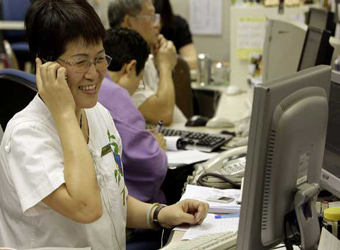Asian shares were in a buoyant mood, with Japanese stocks hitting their highest close in nearly six years after the yen fell sharply on relatively positive U.S. economic data, while two major regional currencies slumped.
Financial bookmakers expected major European indexes .FTSE .GDAXI .FCHI to open flat to modestly higher on Thursday .
U.S. jobless claims unexpectedly fell last week and the November Thomson Reuters/University of Michigan consumer confidence improved from a preliminary reading, while the Chicago PMI held up better than expected last month after surging in October.
A soft October durable goods report was the only dent to an otherwise upbeat set of figures.
“The U.S. economic data were very pro-tapering, despite the weakness in the durable goods data,” Steven Englander, global head of G10 FX strategy at Citigroup, wrote in a note.
The Indonesian rupiah fell to its psychological support at 12,000 per dollar, the first time since March 2009. The currency is seen vulnerable to capital outflows once the U.S. Federal Reserve begins dialing back the massive stimulus that has fuelled asset prices in emerging markets.
Investors are focusing more closely on data as they weigh the odds of when the Fed is likely to start unwinding its $85 billion-a-month bond-buying campaign. Many investors expect the Fed will begin tapering in the first quarter of next year if the economy continues to improve.
“On tapering and USD, we have been struck by how much of the market continues to assign a very low probability of a December or January tapering,” Englander said.
“Investors are focused on next week’s labor market release, but the stronger than expected data suggests that some revision of probabilities is merited even going into the numbers.”
The dollar hit a six-month high against of 102.28 yen, adding to a 0.8 percent gain overnight and setting its sight on a 4-1/2 peak of 103.74 yen reached in May.
As the yen tumbled, Tokyo’s Nikkei .N225 finished up 1.8 percent at 15,727.12, the highest closing level since December 2007.
The Nikkei is up 51 percent this year in local currency terms, outpacing a 27 percent jump in the U.S. S&P 500 .SPX and a 16 percent rise in the STOXX Europe 600 .STOXX index.
Investors have been using the yen as a funding currency for carry trades with the Bank ofJapan committed to keeping ultra-loose monetary policy to shore up growth — a contrast with the Fed which is moving towards a turn in policy.
ASIA UNDERPERFORMS
The Thai baht dropped to an 11-week low of 32.20 per dollar as October manufacturing output fell more than expected, adding to the country’s economic woes as political tensions heightened. The SET index .SETI dipped 0.1 percent.
MSCI’s broadest index of Asia-Pacific shares outside Japan .MIAPJ0000PUS rose 0.6 percent, hitting a one-week high. Still, the Asian gauge is only up 1.7 percent this year, sharply underperforming U.S., European and Japanese share markets.
On Wednesday, the Dow Jones industrial average .DJI and the S&P 500 closed at record highs while the tech-heavy Nasdaq .IXIC finished at a 13-year peak. U.S. markets will be closed on Thursday for Thanksgiving.
The euro was steady at $1.3585, having hit a four-week high in the previous session after news that Germany’s two major parties had formed a grand coalition.
The Australian dollar climbed 0.5 percent to $0.9126 on the day, further off a three-month low, after better than expected business investment data reinforced expectations that the Reserve Bank of Australia is unlikely to cut its base rate from the current record low of 2.5 percent.
“In a year’s time, we’re probably looking at growth heading back to around 3 percent, which is more optimistic than what the RBA was expressing,” said Shane Oliver, chief economist at AMP Capital Investors.
“Ultimately, it would also be consistent with it leaving rates on hold ahead of a possible rate hike sometime around September or October next year.”
U.S. crude prices was steady at around $92.3 a barrel, pausing after a 1.5 percent slide overnight as a higher than expected build in inventories weighed down prices.
Gold gained 0.3 percent to about $1,241.7 an ounce, recouping a 0.4 percent decline in the previous session and moving away from a four-month low of $1,227.34 hit on Monday.
Source: Reuters





